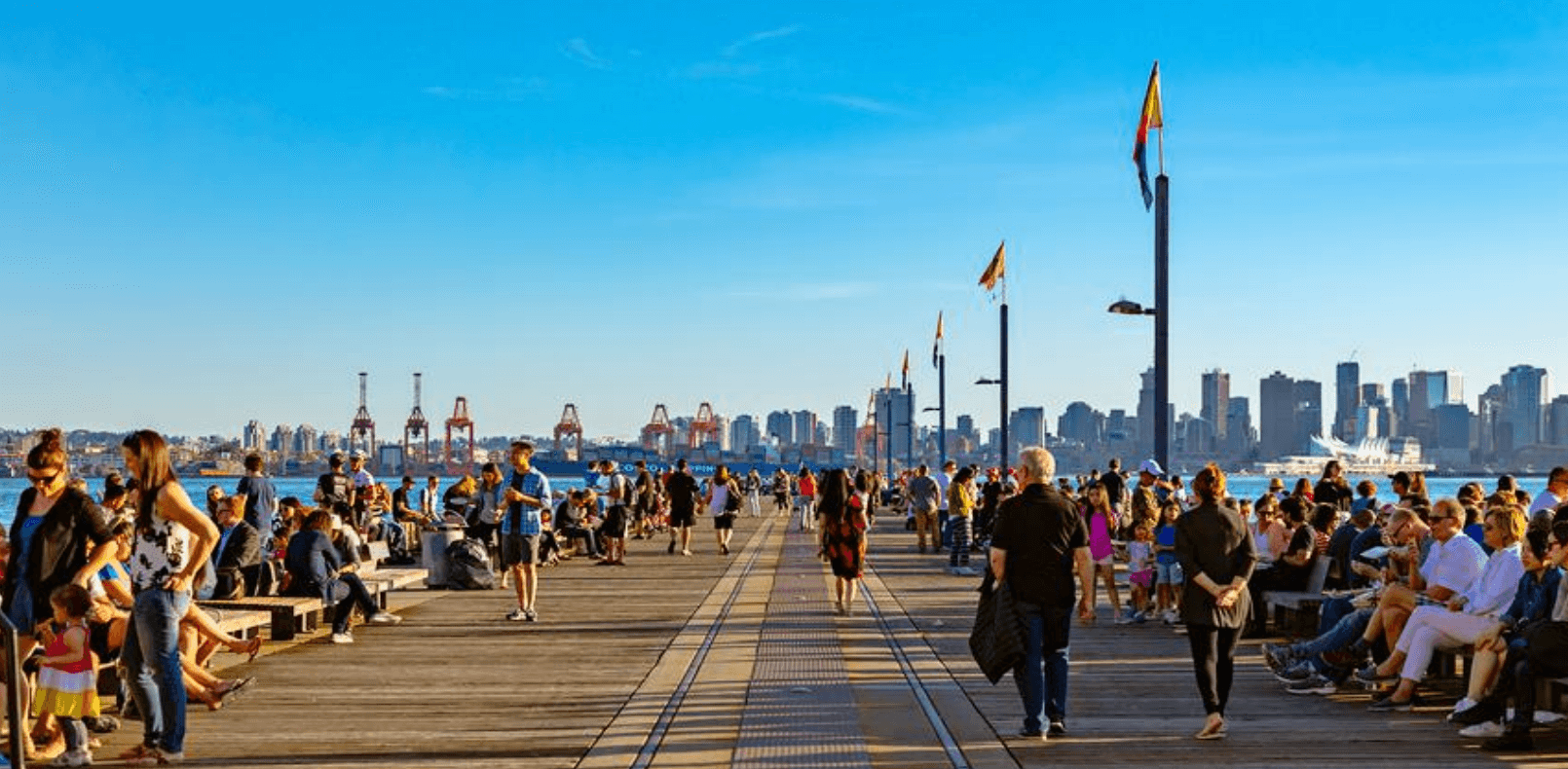Published: March 2024
Published: March 2024
Introduction
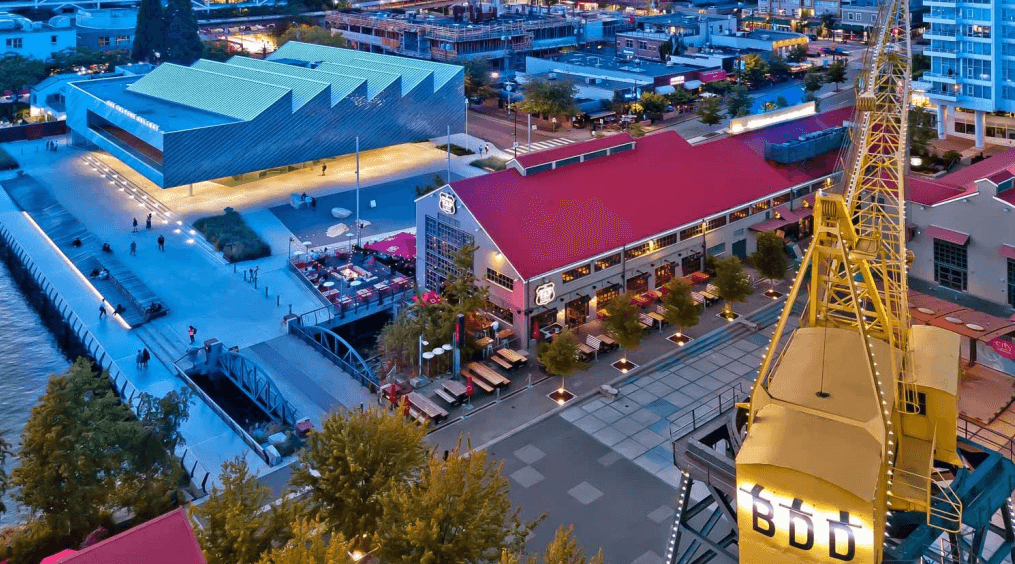
The Shipyards is situated on the traditional and unceded shared territories of the xʷməθkwəy̓əm (Musqueam), Skwxwú7mesh (Squamish), and Səl ̓ ílwətaɬ (Tsleil-Waututh) Nations. At the water’s edge, this once Squamish Nation village became the location of the traditional ship building area of North Vancouver in British Columbia. Since 2017, the original area has been regenerated into an 85,000 square foot commercial and community amenity space to become a vibrant shopping and attraction for both residents and visitors alike. The destination is a valuable case study illustrating re-development and destination development which celebrates public spaces, community-led initiatives and collaborative efforts. Reflecting on the site’s history, offerings and partnerships, it is easy to see how the Shipyards has become a destination model that other cities are looking to replicate.
Introduction

The Shipyards is situated on the traditional and unceded shared territories of the xʷməθkwəy̓əm (Musqueam), Skwxwú7mesh (Squamish), and Səl ̓ ílwətaɬ (Tsleil-Waututh) Nations. At the water’s edge, this once Squamish Nation village became the location of the traditional ship building area of North Vancouver in British Columbia. Since 2017, the original area has been regenerated into an 85,000 square foot commercial and community amenity space to become a vibrant shopping and attraction for both residents and visitors alike. The destination is a valuable case study illustrating re-development and destination development which celebrates public spaces, community-led initiatives and collaborative efforts. Reflecting on the site’s history, offerings and partnerships, it is easy to see how the Shipyards has become a destination model that other cities are looking to replicate.
History
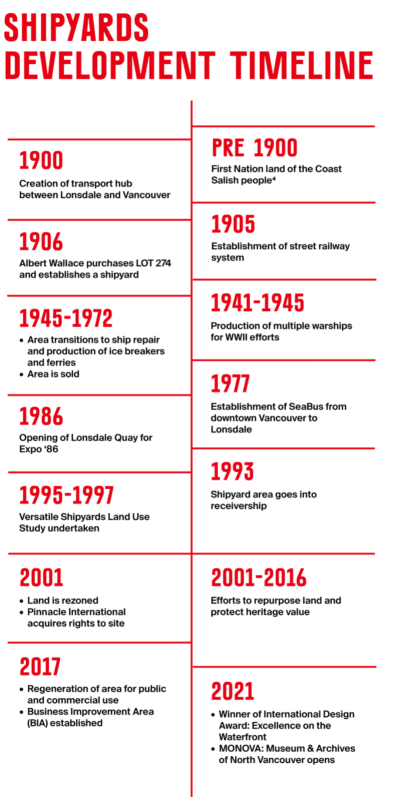
In 1906, the Wallace Shipyard opened at the base of Lonsdale on Vancouver’s North Shore. Owned and operated by Alfred Wallace, the area grew to become one of Canada’s main warship producers constructing 109 out of 312 ‘Victory Ships’ produced in Canada1 . The area comprised of 18 city blocks and transitioned after World War II to become a shipyard repair industry as well as continuing to build some ships including ice breakers and super ferries. In 1971, the Wallace family sold the Shipyards. The area started to go into industrial decline, however, new types of business started to become established such as the SeaBus in 1977, the opening of Lonsdale Quay for Expo 1986 and the creation of mixed-use housing.
Although transitioning, in approximately 1993, the once bustling Shipyards went into receivership and applications were put forth to demolish the area. Although the site had historical significance, a request for access to the site to conduct a Heritage Inventory was denied. Repurposing the area and recognizing the heritage value took a massive investment of both time and capital as it was considered industrial and somewhat unsafe. A few individuals, however, saw the value of both heritage and tourism. This vision can be credited to Gary Penway who started the city’s Heritage Program in 1987 and was a city planner at the time. He persuaded the Mayor, John Loucks to shift the land use of the area and have it rezoned. In 1991, the Versatile Shipyards Heritage Inventory was completed, and it ranked buildings of various levels of heritage significance2 . The Shipyards owners, however, felt that no building had any historical significance. From 1995-1997, a Versatile Shipyards Land Use Study was conducted by Price Waterhouse Coopers and the Vancouver Port Authority to showcase the potential for public waterfront access, heritage conservation, residential as well as commercial use3 . By 2001, the land was rezoned and Pinnacle International acquired rights to build a pier development on the brownfield site.
1 The Shipyards District. Last accessed October 2023 from https://theshipyardsdistrict.ca/resources/shipyardshistory - :~:text=Owned and operated by Alfred,repair industry became more prevalent
2 Thomas, S. (n.d.) Gary Penway on how the Shipyards almost didn’t happen. Last accessed October, 2023 from https://monova.ca/gary-penwayon-how-the-shipyards-almost-didnt-happen/
3 ibid
4 MONOVA: Museum and Archives of North Vancouver (n.d.) Connections Speaker Series: A Planning History of The Shipyards
1 The Shipyards District. Last accessed October 2023 from https://theshipyardsdistrict.ca/resources/shipyardshistory - :~:text=Owned and operated by Alfred,repair industry became more prevalent
2 Thomas, S. (n.d.) Gary Penway on how the Shipyards almost didn’t happen. Last accessed October, 2023 from https://monova.ca/gary-penwayon-how-the-shipyards-almost-didnt-happen/
3 ibid
4 MONOVA: Museum and Archives of North Vancouver (n.d.) Connections Speaker Series: A Planning History of The Shipyards
The present
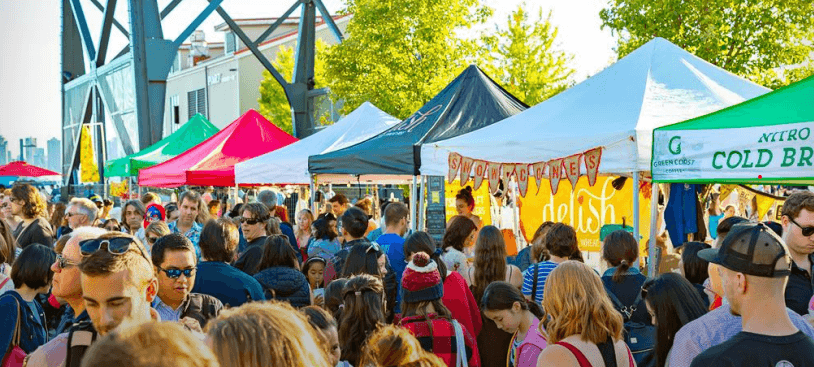
After 16 years, the area has become branded ‘The Shipyards District’. Many buildings from the original site were destroyed, however, some original ones still stand today, and the area is a mix of old and new development. The area attracts over 50,000 visitors in the peak summer months, and the Shipyards District is well positioned and considered accessible, walkable as well as a transportation hub. For example, the SeaBus in adjacent Lonsdale Quay connects downtown Vancouver to the North Shore docks and there is also a bus terminal providing good active transport and ease of access. Along with being a transport hub for residents, it is also accessible for visitors. The SeaBus, the local form of public transportation is marketed as a 12-minute harbourcruise which is a key attraction for cruise ship passengers. Discover Canada, a tour operator, includes the Shipyards as a stop on their tour and Cypress Mountain picks up skiers right next to the Shipyards and takes them to one of the three local mountains on the North Shore.
The long-standing North Shore attraction, Capilano Suspension Bridge also plans to add the Shipyards District as a regular pick-up/drop-off spot for their own bus link. The Shipyards is a destination for both visitors as well as the local community. It is home to a public and free ice rink in the winter and a children’s water park in the summer. Fire pits, shopping, a boutique hotel, concerts and markets, food and beverage and events create an interactive and vibrant place. Special programming also targets the community. For example, free yoga classes as well as pickleball classes are offered for residents in addition to car free days and public festivals and events. This once degenerated infrastructure now is home to parks, boardwalks, piers and public gathering spaces offering year-round events and culture. There is also a strong business mix of small independent operators which give character and identity to the area. They have established a strong, collaborative partnership with city partners which keeps the area independent and creates a unique destination.
The present

After 16 years, the area has become branded ‘The Shipyards District’. Many buildings from the original site were destroyed, however, some original ones still stand today, and the area is a mix of old and new development. The area attracts over 50,000 visitors in the peak summer months, and the Shipyards District is well positioned and considered accessible, walkable as well as a transportation hub. For example, the SeaBus in adjacent Lonsdale Quay connects downtown Vancouver to the North Shore docks and there is also a bus terminal providing good active transport and ease of access. Along with being a transport hub for residents, it is also accessible for visitors. The SeaBus, the local form of public transportation is marketed as a 12-minute harbourcruise which is a key attraction for cruise ship passengers. Discover Canada, a tour operator, includes the Shipyards as a stop on their tour and Cypress Mountain picks up skiers right next to the Shipyards and takes them to one of the three local mountains on the North Shore.
The long-standing North Shore attraction, Capilano Suspension Bridge also plans to add the Shipyards District as a regular pick-up/drop-off spot for their own bus link. The Shipyards is a destination for both visitors as well as the local community. It is home to a public and free ice rink in the winter and a children’s water park in the summer. Fire pits, shopping, a boutique hotel, concerts and markets, food and beverage and events create an interactive and vibrant place. Special programming also targets the community. For example, free yoga classes as well as pickleball classes are offered for residents in addition to car free days and public festivals and events. This once degenerated infrastructure now is home to parks, boardwalks, piers and public gathering spaces offering year-round events and culture. There is also a strong business mix of small independent operators which give character and identity to the area. They have established a strong, collaborative partnership with city partners which keeps the area independent and creates a unique destination.
The partnership
The approval of the area took a long time and is attributed to partnership and collaboration among multiple parties.
Partners include:
- City of North Vancouver who is the owner of the land and built infrastructure. They have a team which activates the area and are responsible for programming and third-party events.
- Quay North Urban Development who manages all commercial space and also operates Lonsdale Quay. The company is a long-term community player.
- The Polygon Gallery operated by the British Columbia Photography and Media Arts Society, a federally registered charity. The gallery was built at the same time as the area was redeveloped and connects the area to the waterfront5.
- The Shipyards District BIA who has the mandate to brand and market the area and focuses on destination development. Every business within a defined boundary is a member of the BIA.
- Vancouver’s North Shore Tourism Association (VNSTA) who assists with promotion of The Shipyards District.
- Seaspan who still builds and fixes ships making the site a continued active shipyard.
5 The Polygon Gallery. Last accessed October 2023 from https://thepolygon.ca/about/#:~:text=The%20Polygon%20Gallery%2 0is,an%20enclosed%20gallery%20space
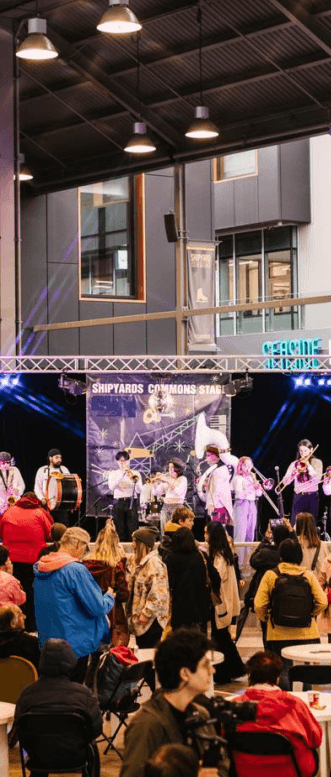
Regenerative tourism aspects

A number of efforts are underway in the Shipyards District that focus on regeneration.
Food security and education:
In 2019, an idea for street beautification, food security and education led to the creation of eight large community garden areas and 26 smaller boxes which are planted during the growing season. The idea is to promote urban gardening and all plants are edible, available and free to everyone. Today, walking tours of the Shipyards District are led by local residents which take school children to 13 educational stops around the area. The idea is to discuss the ’13 reasons to grow’ which discusses self-sufficiency and gardening.
Culture:
The Shipyards District is home to six museums and galleries in the area who call themselves the cultural precinct. As well as some of the buildings being architecturally unique, there are museums which focus on education about Indigenous history as well as the history of North Vancouver. For example, MONOVA is continuously working to promote heritage and history of Indigenous projects and stories and has been offering programming to people of all ages. The Polygon Gallery expands and celebrates this with low barriers to participate: entry is by donation.
Funding:
The establishment of The Shipyards District BIA is a collaborative approach. In essence, it is a vehicle to generate financial resources for the community and the community itself decides how these resources will be spent. The idea is that by being a ground up collaborative collective, it will advance prosperity for all.
Regenerative tourism aspects

A number of efforts are underway in the Shipyards District that focus on regeneration.
Food security and education:
In 2019, an idea for street beautification, food security and education led to the creation of eight large community garden areas and 26 smaller boxes which are planted during the growing season. The idea is to promote urban gardening and all plants are edible, available and free to everyone. Today, walking tours of the Shipyards District are led by local residents which take school children to 13 educational stops around the area. The idea is to discuss the ’13 reasons to grow’ which discusses self-sufficiency and gardening.
Culture:
The Shipyards District is home to six museums and galleries in the area who call themselves the cultural precinct. As well as some of the buildings being architecturally unique, there are museums which focus on education about Indigenous history as well as the history of North Vancouver. For example, MONOVA is continuously working to promote heritage and history of Indigenous projects and stories and has been offering programming to people of all ages. The Polygon Gallery expands and celebrates this with low barriers to participate: entry is by donation.
Funding:
The establishment of The Shipyards District BIA is a collaborative approach. In essence, it is a vehicle to generate financial resources for the community and the community itself decides how these resources will be spent. The idea is that by being a ground up collaborative collective, it will advance prosperity for all.
Future outlook
Seasonality:
The Shipyards District offers year-round programming which is focused on both community and visitors alike. In the winter, there is a free skating rink along with fire pits and festivals which are held under cover. In the summer, there are water park, boardwalk, events and food experiences. The area also focuses on the fall season with their signature event: the Shipyards festival which attracted over 30,000 visitors for the one-day musical event in September 2022.
Murals:
The City of North Vancouver also co-funded and championed mural installation. One is located at the north end of the pier known as ‘the Bunker’, a storage area that was considered an old industrial eyesore. In 2021, master weavers Debra Sparrow, Chief Janice George (Skwxwú7mesh) and Angela George (səlilwətaɬ) collaborated on the first semi-permanent public art installation. The mural, representing cooperation from the three local nations, depicts the story of the Great Vancouver Fire and the role that Indigenous first responders played in bringing people to safety across the Burrard Inlet6.
6 Blanketing the City, 2023 Last accessed November 2023 from https://vanmuralfest.ca/community-projects/blanketing-the-city
7 https://www.instagram.com/fun_alley/?hl=en
8 604now, 2023. Last accessed November 2023 from https://604now.com/north-vancouver-mural-brightens-fall/

Another mural, known as fun alley, is located in lower Lonsdale on West 1st Street between Lift breakfast bakery and Buddha-Full vegan eatery, and it is becoming the most ‘instagrammable’ spot in town and even has its own page on Instagram7 . North Vancouver’s public art program provides local youth artists ages 15-19 with opportunities to work alongside experienced mentors who are often up-and-coming artists8 .
The future

The City of North Vancouver has shown bold leadership in re-developing the waterfront area into a renowned Vancouver destination. They have invested into its on-going activation and programming year-round. On any given day of the year, the area is a buzz with things do and see.
For the local Shipyards District BIA, the next few years will feature a renewed focus on placemaking, wayfinding and enticing visitors to wander further up and into the neighbourhood to visit the vibrant local shops and eateries that call The Shipyards District home. The area is also considering their climate impact and upgrading electrical solutions to ensure major outdoor events and festivals, which the area has become known for, can use the local, climate conscious grid9.
9 https://www.cnv.org/business-development/lonsdale-energy. Last accessed December 2023
Written by:
Rachel Dodds, Sustainable Tourism Expert and Professor at Toronto Metropolitan University.
The future

The City of North Vancouver has shown bold leadership in re-developing the waterfront area into a renowned Vancouver destination. They have invested into its on-going activation and programming year-round. On any given day of the year, the area is a buzz with things do and see.
For the local Shipyards District BIA, the next few years will feature a renewed focus on placemaking, wayfinding and enticing visitors to wander further up and into the neighbourhood to visit the vibrant local shops and eateries that call The Shipyards District home. The area is also considering their climate impact and upgrading electrical solutions to ensure major outdoor events and festivals, which the area has become known for, can use the local, climate conscious grid9.
9 https://www.cnv.org/business-development/lonsdale-energy. Last accessed December 2023
Written by:
Rachel Dodds, Sustainable Tourism Expert and Professor at Toronto Metropolitan University.
